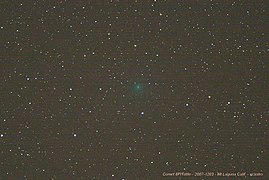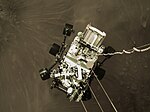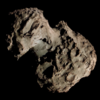astro.wikisort.org - Comet
8P/Tuttle (also known as Tuttle's Comet or Comet Tuttle) is a periodic comet with a 13.6-year orbit. It fits the classical definition of a Jupiter-family comet with an orbital period of less than 20 years, but does not fit the modern definition of (2 < TJupiter< 3).[2] Its last perihelion passage was 27 August 2021 when it had a solar elongation of 26 degrees at approximately apparent magnitude 9.[6] Two weeks later, on September 12, 2021, it was about 1.8 AU (270 million km) from Earth which is about as far from Earth as the comet can get when the comet is near perihelion.
 | |
| Discovery | |
|---|---|
| Discovered by | Horace Parnell Tuttle |
| Discovery date | January 5, 1858 |
| Alternative designations | 1790 II; 1858 I; 1871 III; 1885 IV; 1899 III; 1912 IV; 1926 IV; 1939 X; 1967 V; 1980 XIII; 1994 XV |
| Orbital characteristics A | |
| Epoch | January 15, 2008 |
| Aphelion | 10.376340 AU |
| Perihelion | 1.027132 AU |
| Semi-major axis | 5.701737 AU |
| Eccentricity | 0.819856 |
| Orbital period | 13.6 a[1] |
| Inclination | 54.9830° |
| Earth MOID | 0.095 AU (14.2 million km)[2] |
| Dimensions | 4.5 km contact binary[2] |
| Last perihelion | August 27, 2021[3][4] January 27, 2008 |
| Next perihelion | 2035-Apr-18[5] |
Comet 8P/Tuttle is responsible for the Ursid meteor shower in late December.[7]
2008 perihelion
Under dark skies, the comet was a naked-eye object. Perihelion was late January 2008 and, as of February, was visible telescopically to Southern Hemisphere observers in the constellation Eridanus. On December 30, 2007, it was in close conjunction with spiral galaxy M33. On January 1, 2008, it passed Earth at a distance of 0.25282 AU (37,821,000 km; 23,501,000 mi).[2]
Predictions that the 2007 Ursid meteor shower could have possibly been stronger than usual due to the return of the comet,[8] did not appear to materialize, as counts were in the range of normal distribution.
Contact binary
Radar observations of Comet Tuttle in January 2008 by the Arecibo Observatory show it to be a contact binary.[9][10] The comet nucleus is estimated at about 4.5 km in diameter, using the equivalent diameter of a sphere having a volume equal to the sum of a 3 km and 4 km sphere.[2]
Additional images

Sun · Venus · Earth · Mars · Jupiter · Saturn · C/2018 V1
- Tuttle on December 3, 2007 from Mount Laguna, California
- About 1.2 degrees from M33 on December 30, 2007.
- Tuttle on Feb 2, 2008 from the Red Sea coast of Egypt.
References
- Ley, Willy (September 1968). "Mission to a Comet". For Your Information. Galaxy Science Fiction. pp. 101–110.
- "JPL Small-Body Database Browser: 8P/Tuttle". NASA/Jet Propulsion Laboratory. June 6, 2008. Retrieved February 25, 2010.
- "8P/Tuttle Orbit". Minor Planet Center. Retrieved January 13, 2021.
- Kinoshita, Kazuo (January 24, 2008). "8P/Tuttle". Comet Orbits.
- "Horizons Batch for 8P/Tuttle (90000179) on 2035-Apr-18" (Perihelion occurs when rdot flips from negative to positive). JPL Horizons. Retrieved September 12, 2021. (JPL K215/14 Soln.date: 2021-Sep-07)
- Seiichi Yoshida (June 28, 2020). "8P/Tuttle". Seiichi Yoshida's Comet Catalog. Retrieved July 20, 2020.
- "Meteor Streams". NASA.gov. Retrieved July 28, 2014.
- Jenniskens, P.; Lyytinen, E.; Nissinen, M.; Yrjölä, I.; Vaubaillon, J. (December 2007). "Strong Ursid shower predicted for 2007 December 22" (PDF). WGN, Journal of the International Meteor Organization. 35 (6): 125–133. Bibcode:2007JIMO...35..125J.
- Schilling, Govert (October 14, 2008). "Comet Tuttle's Split Personality". Science. Retrieved October 25, 2008.
- Harmon, J. K.; Nolan, M. C.; Howell, E. S.; Giorgini, J. D. (2008). Comet 8P/Tuttle: Arecibo Radar Observations of the First Bilobate Comet (PDF). 10th Asteroids, Comets, Meteors. 13–18 July 2008. Baltimore, Maryland. Lunar and Planetary Institute.
External links
- Orbital simulation from JPL (Java) / Horizons Ephemeris
- 8P/Tuttle – Seiichi Yoshida @ aerith.net
- 8P at Kronk's Cometography
- 8P/Tuttle time sequence
- Comet Tuttle Seen To Be Returning
- Comet 8P/Tuttle. Canary Islands, Tenerife. 06.01.2008
- NASA Orbital Diagram
На других языках
[de] 8P/Tuttle
8P/Tuttle ist ein periodischer Komet der Jupiter-Familie. Die Bahn des Kometen verläuft zwischen der Erde und dem Saturn mit einer Umlaufzeit von 13,61 Jahren[1]. Mit Hilfe von Radiowellenbeobachtungen konnte Anfang 2008 die Rotationsperiode des Kerns des Kometen bestimmt werden. Danach dreht sich der Kern in 7,5 Stunden um sich selbst.[2]- [en] 8P/Tuttle
[es] 8P/Tuttle
8P/Tuttle es un cometa periódico Sistema Solar, perteneciente a la familia del cometa Halley.[2] El cometa fue descubierto en el 9 de enero de 1790 por el astrónomo francés Pierre Méchain El cometa fue visible durante un corto período, la última observación fue realizada el 1 de febrero de ese año. Méchain no calculó la órbita y el número insuficiente de observaciones no permiten reconocer el comportamiento periódico del cometa.[ru] 8P/Туттля
Комета Туттля[5] (Таттла; 8P/Tuttle) — короткопериодическая комета из семейства Юпитера, которая была открыта 9 января 1790 года французским астрономом Пьером Мешеном вблизи звезды омикрон Рыб. В начале XX века было обнаружено, что данная комета является родоначальницей метеорного потока Урсиды с радиантом в созвездии Малой Медведицы (лат. Ursa Minor). Пик активности этого небольшого метеорного потока приходится на 22 декабря, а число метеоров в час обычно бывает около десяти, хотя в 1945 и 1986 годах случались вспышки до ста, а в 1973 году — до тридцати метеоров в час[6]. Комета обладает довольно коротким периодом обращения вокруг Солнца — чуть более 13,6 года.Другой контент может иметь иную лицензию. Перед использованием материалов сайта WikiSort.org внимательно изучите правила лицензирования конкретных элементов наполнения сайта.
WikiSort.org - проект по пересортировке и дополнению контента Википедии







